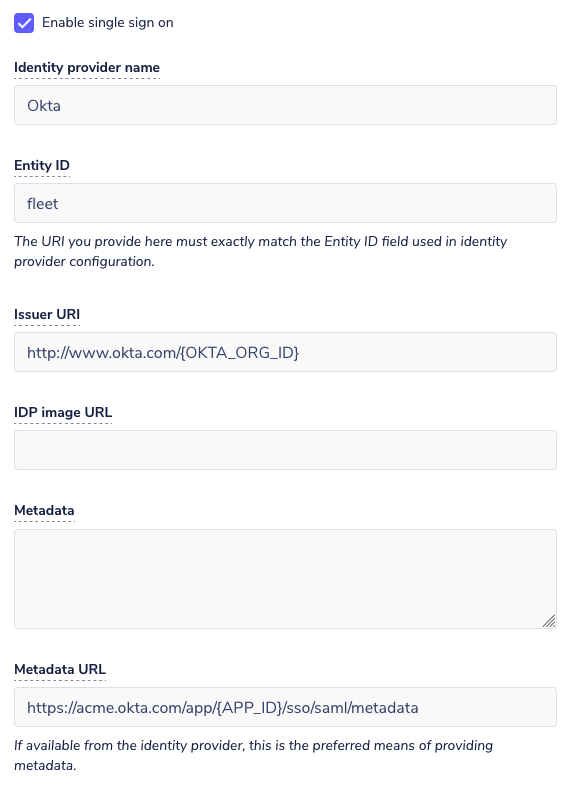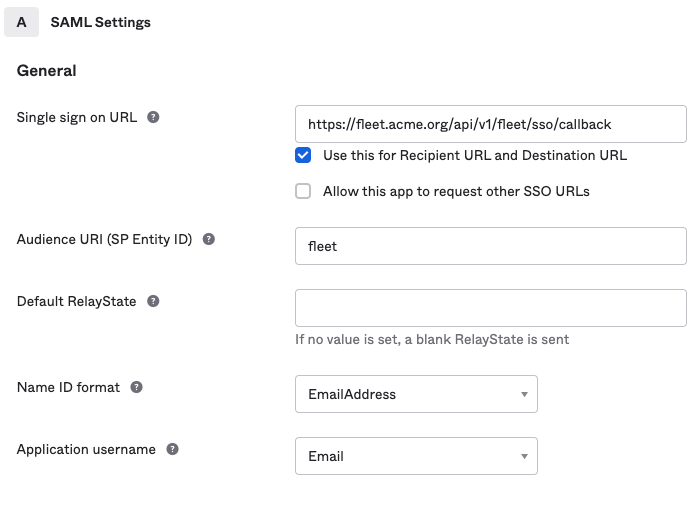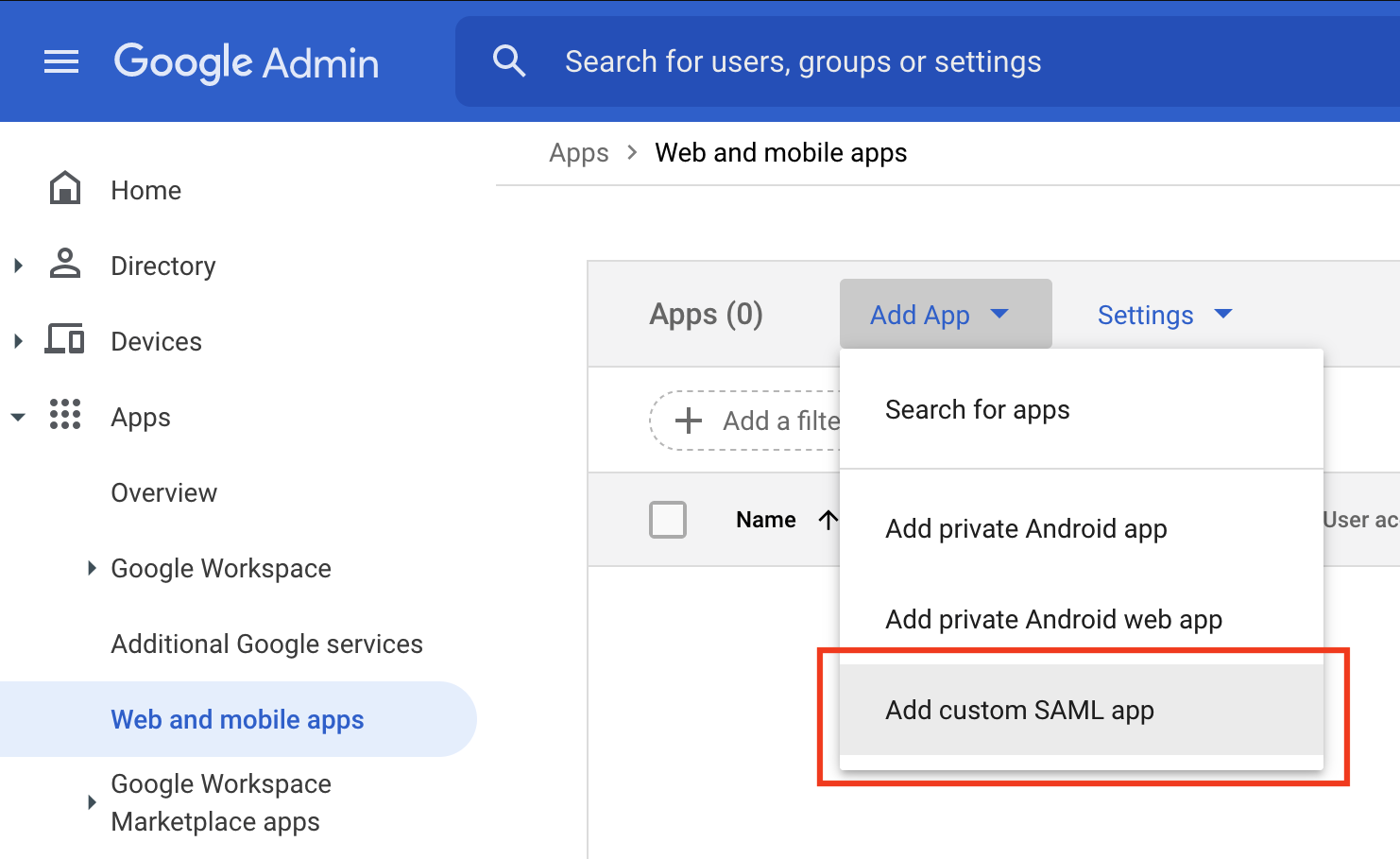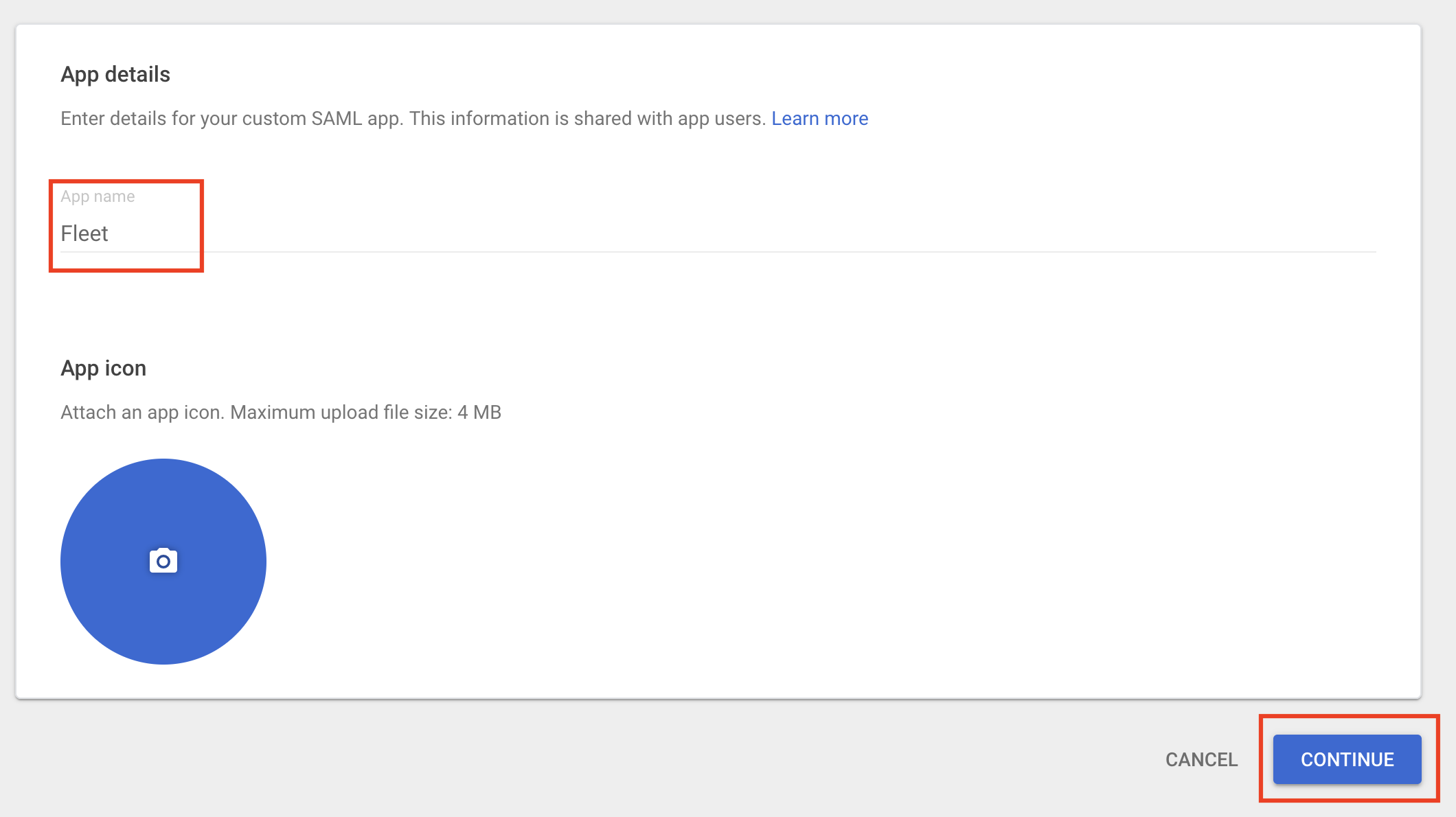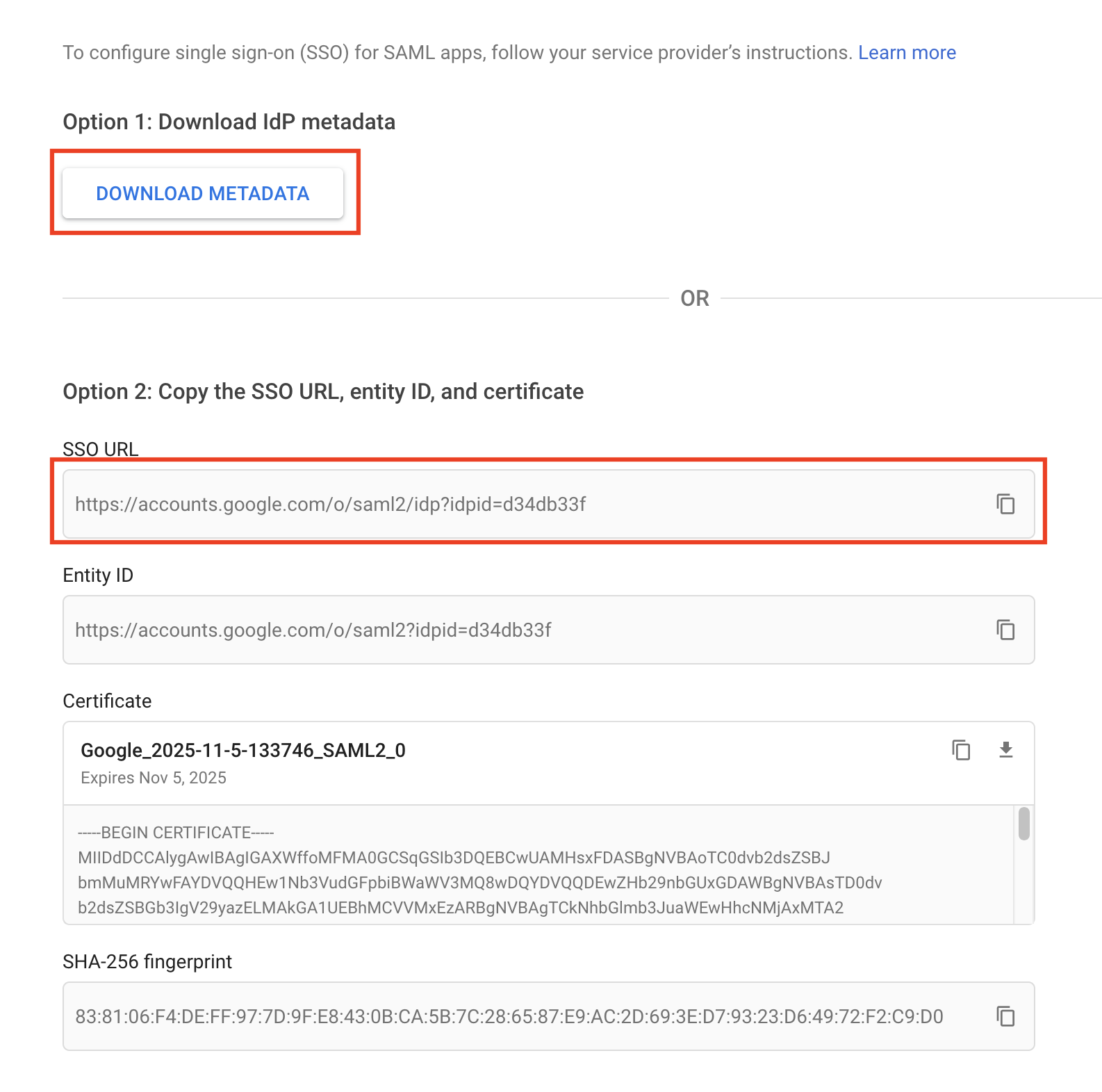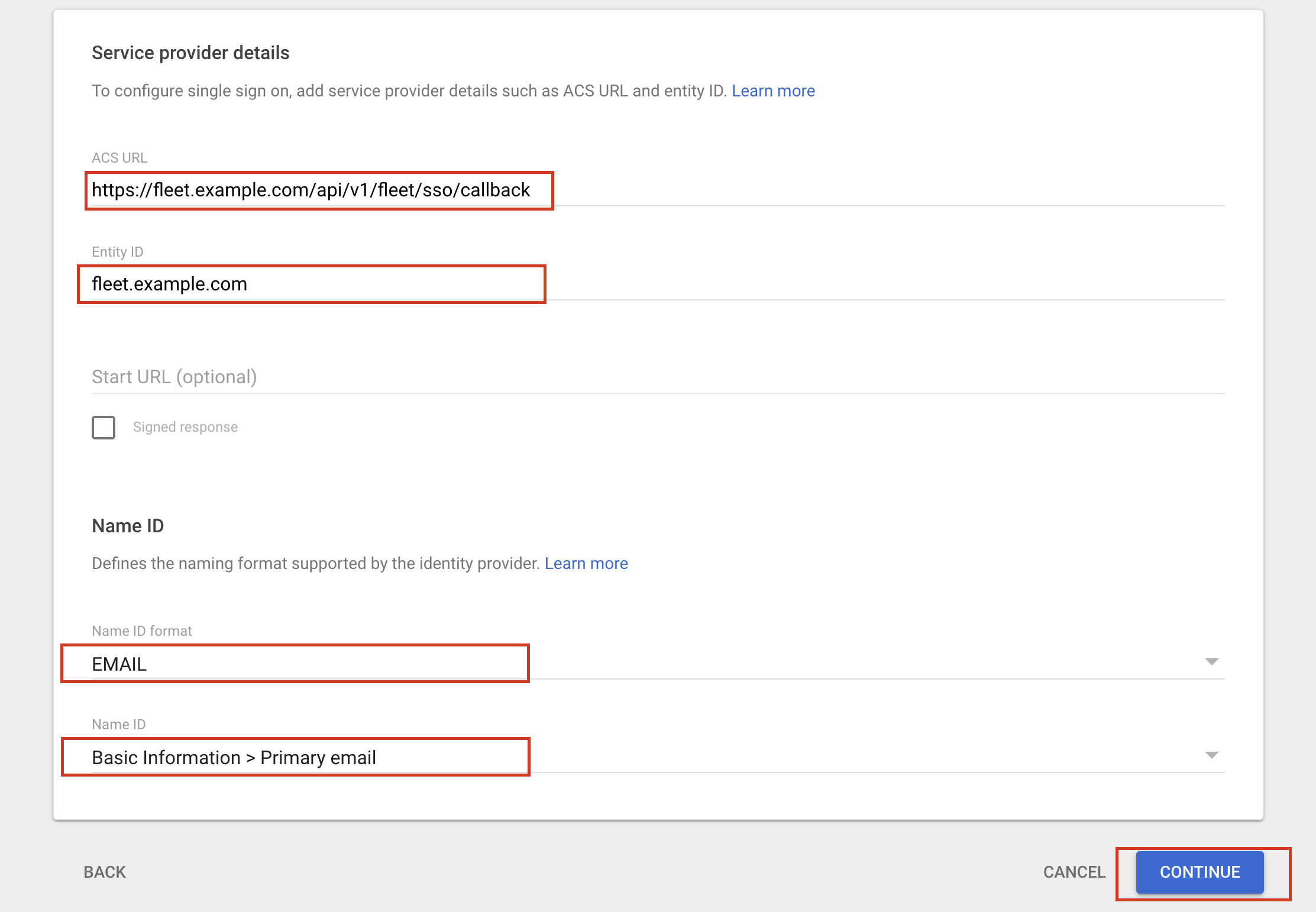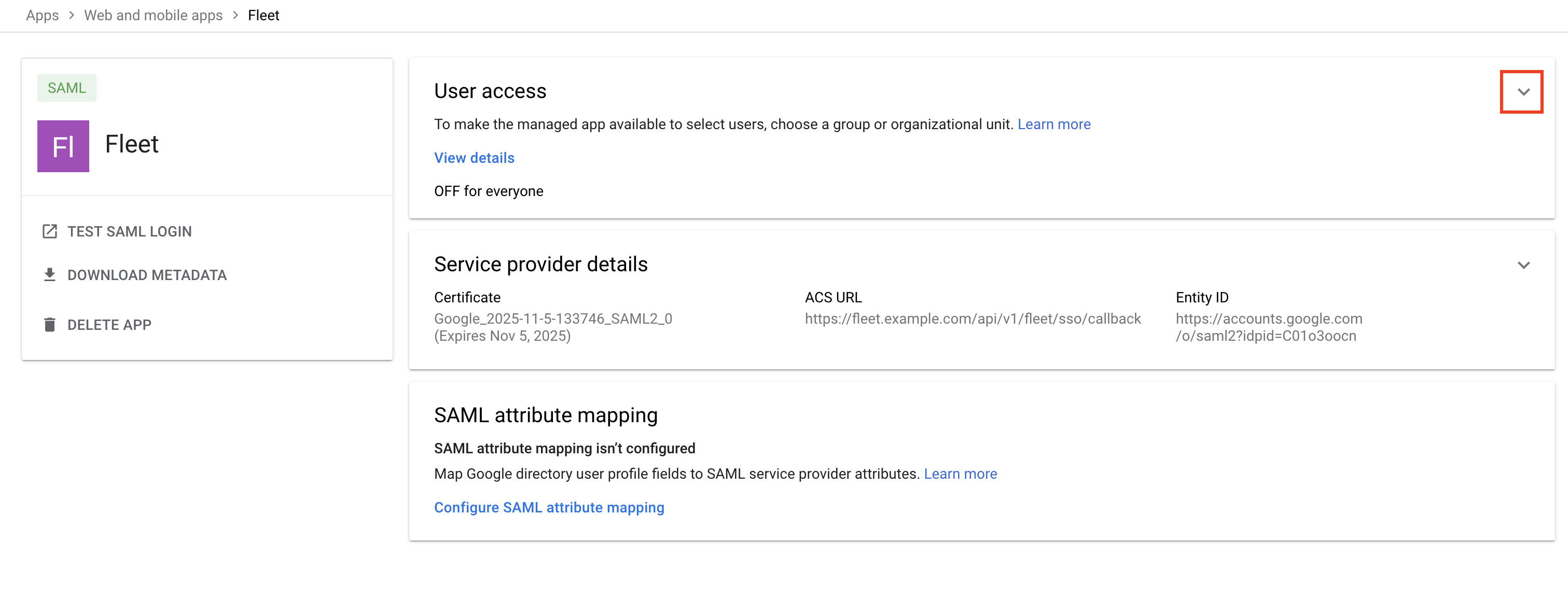* add support for minio backend file carving * add changes file Co-authored-by: Zach Wasserman <zach@fleetdm.com>
47 KiB
Configuration
- Configuring the Fleet binary
- Managing osquery configurations
- Running with systemd
- Configuring single sign on
- Feature flags
Configuring the Fleet binary
For information on how to run the fleet binary, detailed usage information can be found by running fleet --help. This document is a more detailed version of the information presented in the help output text. If you prefer to use a CLI instead of a web browser, we hope that you like the binary interface to the Fleet application!
High-level configuration overview
To get the most out of running the Fleet server, it is helpful to establish a mutual understanding of what the desired architecture looks like and what it's trying to accomplish.
Your Fleet server's two main purposes are:
- To serve as your osquery TLS server
- To serve the Fleet web UI, which allows you to manage osquery configuration, query hosts, etc.
The Fleet server allows you persist configuration, manage users, etc. Thus, it needs a database. Fleet uses MySQL and requires you to supply configurations to connect to a MySQL server. It is also possible to configure connection to a MySQL replica in addition to the primary, to be used for reading only. Fleet also uses Redis to perform some more high-speed data access action throughout the lifecycle of the application (for example, distributed query result ingestion). Thus, Fleet also requires that you supply Redis connection configurations.
Fleet does not support Redis Cluster or Redis Sentinel. Fleet can scale to hundreds of thousands of devices with a single Redis instance.
Since Fleet is a web application, when you run Fleet there are some other configurations that must be defined, such as:
- The TLS certificates that Fleet should use to terminate TLS.
When deploying Fleet, mitigate DoS attacks as you would when deploying any app.
Since Fleet is an osquery TLS server, you are also able to define configurations that can customize your experience there, such as:
- The destination of the osquery status and result logs on the local filesystem
- Various details about the refresh/check-in intervals for your hosts
Commands
The fleet binary contains several "commands". Similarly to how git has many commands (git status, git commit, etc), the fleet binary accepts the following commands:
fleet prepare dbfleet servefleet versionfleet config_dump
Options
How do you specify options?
In order of precedence, options can be specified via:
- A configuration file (in YAML format)
- Environment variables
- Command-line flags
For example, all of the following ways of launching Fleet are equivalent:
Using only CLI flags
/usr/bin/fleet serve \
--mysql_address=127.0.0.1:3306 \
--mysql_database=fleet \
--mysql_username=root \
--mysql_password=toor \
--redis_address=127.0.0.1:6379 \
--server_cert=/tmp/server.cert \
--server_key=/tmp/server.key \
--logging_json
Using only environment variables
FLEET_MYSQL_ADDRESS=127.0.0.1:3306 \
FLEET_MYSQL_DATABASE=fleet \
FLEET_MYSQL_USERNAME=root \
FLEET_MYSQL_PASSWORD=toor \
FLEET_REDIS_ADDRESS=127.0.0.1:6379 \
FLEET_SERVER_CERT=/tmp/server.cert \
FLEET_SERVER_KEY=/tmp/server.key \
FLEET_LOGGING_JSON=true \
/usr/bin/fleet serve
Using a config file
echo '
mysql:
address: 127.0.0.1:3306
database: fleet
username: root
password: toor
redis:
address: 127.0.0.1:6379
server:
cert: /tmp/server.cert
key: /tmp/server.key
logging:
json: true
' > /tmp/fleet.yml
fleet serve --config /tmp/fleet.yml
What are the options?
Note that all option names can be converted consistently from flag name to environment variable and visa-versa. For example, the --mysql_address flag would be the FLEET_MYSQL_ADDRESS. Further, specifying the mysql_address option in the config would follow the pattern:
mysql:
address: 127.0.0.1:3306
And mysql_read_replica_address would be:
mysql_read_replica:
address: 127.0.0.1:3307
Basically, just capitalize the option and prepend FLEET_ to it in order to get the environment variable. The conversion works the same the opposite way.
All duration-based settings accept valid time units of s, m, h.
MySQL
This section describes the configuration options for the primary - if you also want to setup a read replica, the options are the same, except that the yaml section is mysql_read_replica, and the flags have the mysql_read_replica_ prefix instead of mysql_ (the corresponding environment variables follow the same transformation). Note that there is no default value for mysql_read_replica_address, it must be set explicitly for fleet to use a read replica, and it is recommended in that case to set a non-zero value for mysql_read_replica_conn_max_lifetime as in some environments, the replica's address may dynamically change to point
from the primary to an actual distinct replica based on auto-scaling options, so existing idle connections need to be recycled
periodically.
mysql_address
The address of the MySQL server which Fleet should connect to. Include the hostname and port.
-
Default value:
localhost:3306 -
Environment variable:
FLEET_MYSQL_ADDRESS -
Config file format:
mysql: address: localhost:3306
mysql_database
The name of the MySQL database which Fleet will use.
-
Default value:
fleet -
Environment variable:
FLEET_MYSQL_DATABASE -
Config file format:
mysql: database: fleet
mysql_username
The username to use when connecting to the MySQL instance.
-
Default value:
fleet -
Environment variable:
FLEET_MYSQL_USERNAME -
Config file format:
mysql: username: fleet
mysql_password
The password to use when connecting to the MySQL instance.
-
Default value:
fleet -
Environment variable:
FLEET_MYSQL_PASSWORD -
Config file format:
mysql: password: fleet
mysql_password_path
File path to a file that contains the password to use when connecting to the MySQL instance.
-
Default value:
"" -
Environment variable:
FLEET_MYSQL_PASSWORD_PATH -
Config file format:
mysql: password_path: '/run/secrets/fleetdm-mysql-password'
mysql_tls_ca
The path to a PEM encoded certificate of MYSQL's CA for client certificate authentication.
-
Default value: none
-
Environment variable:
FLEET_MYSQL_TLS_CA -
Config file format:
mysql: tls_ca: /path/to/server-ca.pem
mysql_tls_cert
The path to a PEM encoded certificate use for tls authentication.
-
Default value: none
-
Environment variable:
FLEET_MYSQL_TLS_CERT -
Config file format:
mysql: tls_cert: /path/to/certificate.pem
mysql_tls_key
The path to a PEM encoded private key use for tls authentication.
-
Default value: none
-
Environment variable:
FLEET_MYSQL_TLS_KEY -
Config file format:
mysql: tls_key: /path/to/key.pem
mysql_tls_config
The tls value in a MYSQL DSN. Can be true,false,skip-verify or the CN value of the certificate.
-
Default value: none
-
Environment variable:
FLEET_MYSQL_TLS_CONFIG -
Config file format:
mysql: tls_config: true
mysql_tls_server_name
The server name or IP address used by the client certificate.
-
Default value: none
-
Environment variable:
FLEET_MYSQL_TLS_SERVER_NAME -
Config file format:
mysql: servername: 127.0.0.1
mysql_max_open_conns
Maximum open connections to database
-
Default value: 50
-
Environment variable:
FLEET_MYSQL_MAX_OPEN_CONNS -
Config file format:
mysql: max_open_conns: 50
mysql_max_idle_conns
Maximum idle connections to database. This value should be equal to or less than mysql_max_open_conns
-
Default value: 50
-
Environment variable:
FLEET_MYSQL_MAX_IDLE_CONNS -
Config file format:
mysql: max_idle_conns: 50
mysql_conn_max_lifetime
Maximum amount of time, in seconds, a connection may be reused.
-
Default value: 0 (Unlimited)
-
Environment variable:
FLEET_MYSQL_CONN_MAX_LIFETIME -
Config file format:
mysql: conn_max_lifetime: 50
Redis
redis_address
The address of the Redis server which Fleet should connect to. Include the hostname and port.
-
Default value:
localhost:6379 -
Environment variable:
FLEET_REDIS_ADDRESS -
Config file format:
redis: address: 127.0.0.1:7369
redis_password
The password to use when connecting to the Redis instance.
-
Default value:
<empty> -
Environment variable:
FLEET_REDIS_PASSWORD -
Config file format:
redis: password: foobar
redis_database
The database to use when connecting to the Redis instance.
-
Default value:
0 -
Environment variable:
FLEET_REDIS_DATABASE -
Config file format:
redis: database: 14
redis_duplicate_results
Whether or not to duplicate Live Query results to another Redis channel named LQDuplicate. This is useful in a scenario that would involve shipping the Live Query results outside of Fleet, near-realtime.
-
Default value:
false -
Environment variable:
FLEET_REDIS_DUPLICATE_RESULTS -
Config file format:
redis: duplicate_results: true
redis_connect_timeout
Timeout for redis connection.
-
Default value: 5s
-
Environment variable:
FLEET_REDIS_CONNECT_TIMEOUT -
Config file format:
redis: connect_timeout: 10s
redis_keep_alive
Interval between keep alive probes.
-
Default value: 10s
-
Environment variable:
FLEET_REDIS_KEEP_ALIVE -
Config file format:
redis: keep_alive: 30s
redis_connect_retry_attempts
Maximum number of attempts to retry a failed connection to a redis node. Only certain type of errors are retried, such as connection timeouts.
-
Default value: 0 (no retry)
-
Environment variable:
FLEET_REDIS_CONNECT_RETRY_ATTEMPTS -
Config file format:
redis: connect_retry_attempts: 2
redis_cluster_follow_redirections
Whether or not to automatically follow redirection errors received from the Redis server. Applies only to Redis Cluster setups, ignored in standalone Redis. In Redis Cluster, keys can be moved around to different nodes when the cluster is unstable and reorganizing the data. With this configuration option set to true, those (typically short and transient) redirection errors can be handled transparently instead of ending in an error.
-
Default value: false
-
Environment variable:
FLEET_REDIS_CLUSTER_FOLLOW_REDIRECTIONS -
Config file format:
redis: cluster_follow_redirections: true
Server
server_address
The address to serve the Fleet webserver.
-
Default value:
0.0.0.0:8080 -
Environment variable:
FLEET_SERVER_ADDRESS -
Config file format:
server: address: 0.0.0.0:443
server_cert
The TLS cert to use when terminating TLS.
See TLS certificate considerations for more information about certificates and Fleet.
-
Default value:
./tools/osquery/fleet.crt -
Environment variable:
FLEET_SERVER_CERT -
Config file format:
server: cert: /tmp/fleet.crt
server_key
The TLS key to use when terminating TLS.
-
Default value:
./tools/osquery/fleet.key -
Environment variable:
FLEET_SERVER_KEY -
Config file format:
server: key: /tmp/fleet.key
server_tls
Whether or not the server should be served over TLS.
-
Default value:
true -
Environment variable:
FLEET_SERVER_TLS -
Config file format:
server: tls: false
server_tls_compatibility
Configures the TLS settings for compatibility with various user agents. Options are modern and intermediate. These correspond to the compatibility levels defined by the Mozilla OpSec team (updated July 24, 2020).
-
Default value:
intermediate -
Environment variable:
FLEET_SERVER_TLS_COMPATIBILITY -
Config file format:
server: tls_compatibility: intermediate
server_url_prefix
Sets a URL prefix to use when serving the Fleet API and frontend. Prefixes should be in the form /apps/fleet (no trailing slash).
Note that some other configurations may need to be changed when modifying the URL prefix. In particular, URLs that are provided to osquery via flagfile, the configuration served by Fleet, the URL prefix used by fleetctl, and the redirect URL set with an SSO Identity Provider.
-
Default value: Empty (no prefix set)
-
Environment variable:
FLEET_SERVER_URL_PREFIX -
Config file format:
server: url_prefix: /apps/fleet
server_keepalive
Controls the server side http keep alive property.
Turning off keepalives has helped reduce outstanding TCP connections in some deployments.
-
Default value: true
-
Environment variable:
FLEET_SERVER_KEEPALIVE -
Config file format:
server: keepalive: true
Auth
auth_bcrypt_cost
The bcrypt cost to use when hashing user passwords.
-
Default value:
12 -
Environment variable:
FLEET_AUTH_BCRYPT_COST -
Config file format:
auth: bcrypt_cost: 14
auth_salt_key_size
The key size of the salt which is generated when hashing user passwords.
-
Default value:
24 -
Environment variable:
FLEET_AUTH_SALT_KEY_SIZE -
Config file format:
auth: salt_key_size: 36
App
app_token_key_size
Size of generated app tokens.
-
Default value:
24 -
Environment variable:
FLEET_APP_TOKEN_KEY_SIZE -
Config file format:
app: token_key_size: 36
app_invite_token_validity_period
How long invite tokens should be valid for.
-
Default value:
5 days -
Environment variable:
FLEET_APP_INVITE_TOKEN_VALIDITY_PERIOD -
Config file format:
app: invite_token_validity_period: 1d
License
license_key
The license key provided to Fleet customers which provides access to Fleet Premium features.
-
Default value: none
-
Environment variable:
FLEET_LICENSE_KEY -
Config file format:
license: key: foobar
Session
session_key_size
The size of the session key.
-
Default value:
64 -
Environment variable:
FLEET_SESSION_KEY_SIZE -
Config file format:
session: key_size: 48
session_duration
The amount of time that a session should last for.
Valid time units are s, m, h.
-
Default value:
4 hours -
Environment variable:
FLEET_SESSION_DURATION -
Config file format:
session: duration: 24h
Osquery
osquery_node_key_size
The size of the node key which is negotiated with osqueryd clients.
-
Default value:
24 -
Environment variable:
FLEET_OSQUERY_NODE_KEY_SIZE -
Config file format:
osquery: node_key_size: 36
osquery_host_identifier
The identifier to use when determining uniqueness of hosts.
Options are provided (default), uuid, hostname, or instance.
This setting works in combination with the --host_identifier flag in osquery. In most deployments, using instance will be the best option. The flag defaults to provided -- preserving the existing behavior of Fleet's handling of host identifiers -- using the identifier provided by osquery. instance, uuid, and hostname correspond to the same meanings as for osquery's --host_identifier flag.
Users that have duplicate UUIDs in their environment can benefit from setting this flag to instance.
-
Default value:
provided -
Environment variable:
FLEET_OSQUERY_HOST_IDENTIFIER -
Config file format:
osquery: host_identifier: uuid
osquery_enroll_cooldown
The cooldown period for host enrollment. If a host (uniquely identified by the osquery_host_identifier option) tries to enroll within this duration from the last enrollment, enroll will fail.
This flag can be used to control load on the database in scenarios in which many hosts are using the same identifier. Often configuring osquery_host_identifier to instance may be a better solution.
-
Default value:
0(off) -
Environment variable:
FLEET_OSQUERY_ENROLL_COOLDOWN -
Config file format:
osquery: enroll_cooldown: 1m
osquery_label_update_interval
The interval at which Fleet will ask osquery agents to update their results for label queries.
Setting this to a higher value can reduce baseline load on the Fleet server in larger deployments.
Valid time units are s, m, h.
-
Default value:
1h -
Environment variable:
FLEET_OSQUERY_LABEL_UPDATE_INTERVAL -
Config file format:
osquery: label_update_interval: 30m
osquery_policy_update_interval
The interval at which Fleet will ask osquery agents to update their results for policy queries.
Setting this to a higher value can reduce baseline load on the Fleet server in larger deployments.
Valid time units are s, m, h.
-
Default value:
1h -
Environment variable:
FLEET_OSQUERY_POLICY_UPDATE_INTERVAL -
Config file format:
osquery: policy_update_interval: 30m
osquery_detail_update_interval
The interval at which Fleet will ask osquery agents to update host details (such as uptime, hostname, network interfaces, etc.)
Setting this to a higher value can reduce baseline load on the Fleet server in larger deployments.
Valid time units are s, m, h.
-
Default value:
1h -
Environment variable:
FLEET_OSQUERY_DETAIL_UPDATE_INTERVAL -
Config file format:
osquery: detail_update_interval: 30m
osquery_status_log_plugin
Which log output plugin should be used for osquery status logs received from clients.
Options are filesystem, firehose, kinesis, lambda, pubsub, and stdout.
-
Default value:
filesystem -
Environment variable:
FLEET_OSQUERY_STATUS_LOG_PLUGIN -
Config file format:
osquery: status_log_plugin: firehose
osquery_result_log_plugin
Which log output plugin should be used for osquery result logs received from clients.
Options are filesystem, firehose, kinesis, lambda, pubsub, and stdout.
-
Default value:
filesystem -
Environment variable:
FLEET_OSQUERY_RESULT_LOG_PLUGIN -
Config file format:
osquery: result_log_plugin: firehose
osquery_max_jitter_percent
Given an update interval (label, or details), this will add up to the defined percentage in randomness to the interval.
The goal of this is to prevent all hosts from checking in with data at the same time.
So for example, if the label_update_interval is 1h, and this is set to 10. It'll add up a random number between 0 and 6 minutes to the amount of time it takes for fleet to give the host the label queries.
-
Default value:
10 -
Environment variable:
FLEET_OSQUERY_MAX_JITTER_PERCENT -
Config file format:
osquery: max_jitter_percent: 10
Logging (Fleet server logging)
logging_debug
Whether or not to enable debug logging.
-
Default value:
false -
Environment variable:
FLEET_LOGGING_DEBUG -
Config file format:
logging: debug: true
logging_json
Whether or not to log in JSON.
-
Default value:
false -
Environment variable:
FLEET_LOGGING_JSON -
Config file format:
logging: json: true
logging_disable_banner
Whether or not to log the welcome banner.
-
Default value:
false -
Environment variable:
FLEET_LOGGING_DISABLE_BANNER -
Config file format:
logging: disable_banner: true
Filesystem
filesystem_status_log_file
This flag only has effect if osquery_status_log_plugin is set to filesystem (the default value).
The path which osquery status logs will be logged to.
-
Default value:
/tmp/osquery_status -
Environment variable:
FLEET_FILESYSTEM_STATUS_LOG_FILE -
Config file format:
filesystem: status_log_file: /var/log/osquery/status.log
filesystem_result_log_file
This flag only has effect if osquery_result_log_plugin is set to filesystem (the default value).
The path which osquery result logs will be logged to.
-
Default value:
/tmp/osquery_result -
Environment variable:
FLEET_FILESYSTEM_RESULT_LOG_FILE -
Config file format:
filesystem: result_log_file: /var/log/osquery/result.log
filesystem_enable_log_rotation
This flag only has effect if osquery_result_log_plugin or osquery_status_log_plugin are set to filesystem (the default value).
This flag will cause the osquery result and status log files to be automatically rotated when files reach a size of 500 Mb or an age of 28 days.
-
Default value:
false -
Environment variable:
FLEET_FILESYSTEM_ENABLE_LOG_ROTATION -
Config file format:
filesystem: enable_log_rotation: true
filesystem_enable_log_compression
This flag only has effect if filesystem_enable_log_rotation is set to true.
This flag will cause the rotated logs to be compressed with gzip.
-
Default value:
false -
Environment variable:
FLEET_FILESYSTEM_ENABLE_LOG_COMPRESSION -
Config file format:
filesystem: enable_log_compression: true
Firehose
firehose_region
This flag only has effect if osquery_status_log_plugin is set to firehose.
AWS region to use for Firehose connection
-
Default value: none
-
Environment variable:
FLEET_FIREHOSE_REGION -
Config file format:
firehose: region: ca-central-1
firehose_access_key_id
This flag only has effect if osquery_status_log_plugin or osquery_result_log_plugin are set to firehose.
If firehose_access_key_id and firehose_secret_access_key are omitted, Fleet will try to use AWS STS credentials.
AWS access key ID to use for Firehose authentication.
-
Default value: none
-
Environment variable:
FLEET_FIREHOSE_ACCESS_KEY_ID -
Config file format:
firehose: access_key_id: AKIAIOSFODNN7EXAMPLE
firehose_secret_access_key
This flag only has effect if osquery_status_log_plugin or osquery_result_log_plugin are set to firehose.
AWS secret access key to use for Firehose authentication.
-
Default value: none
-
Environment variable:
FLEET_FIREHOSE_SECRET_ACCESS_KEY -
Config file format:
firehose: secret_access_key: wJalrXUtnFEMI/K7MDENG/bPxRfiCYEXAMPLEKEY
firehose_sts_assume_role_arn
This flag only has effect if osquery_status_log_plugin or
osquery_result_log_plugin are set to firehose.
AWS STS role ARN to use for Firehose authentication.
-
Default value: none
-
Environment variable:
FLEET_FIREHOSE_STS_ASSUME_ROLE_ARN -
Config file format:
firehose: sts_assume_role_arn: arn:aws:iam::1234567890:role/firehose-role
firehose_status_stream
This flag only has effect if osquery_status_log_plugin is set to firehose.
Name of the Firehose stream to write osquery status logs received from clients.
-
Default value: none
-
Environment variable:
FLEET_FIREHOSE_STATUS_STREAM -
Config file format:
firehose: status_stream: osquery_status
The IAM role used to send to Firehose must allow the following permissions on the stream listed:
firehose:DescribeDeliveryStreamfirehose:PutRecordBatch
firehose_result_stream
This flag only has effect if osquery_result_log_plugin is set to firehose.
Name of the Firehose stream to write osquery result logs received from clients.
-
Default value: none
-
Environment variable:
FLEET_FIREHOSE_RESULT_STREAM -
Config file format:
firehose: result_stream: osquery_result
The IAM role used to send to Firehose must allow the following permissions on the stream listed:
firehose:DescribeDeliveryStreamfirehose:PutRecordBatch
Kinesis
kinesis_region
This flag only has effect if osquery_status_log_plugin is set to kinesis.
AWS region to use for Kinesis connection
-
Default value: none
-
Environment variable:
FLEET_KINESIS_REGION -
Config file format:
kinesis: region: ca-central-1
kinesis_access_key_id
This flag only has effect if osquery_status_log_plugin or
osquery_result_log_plugin are set to kinesis.
If kinesis_access_key_id and kinesis_secret_access_key are omitted, Fleet
will try to use
AWS STS
credentials.
AWS access key ID to use for Kinesis authentication.
-
Default value: none
-
Environment variable:
FLEET_KINESIS_ACCESS_KEY_ID -
Config file format:
kinesis: access_key_id: AKIAIOSFODNN7EXAMPLE
kinesis_secret_access_key
This flag only has effect if osquery_status_log_plugin or
osquery_result_log_plugin are set to kinesis.
AWS secret access key to use for Kinesis authentication.
-
Default value: none
-
Environment variable:
FLEET_KINESIS_SECRET_ACCESS_KEY -
Config file format:
kinesis: secret_access_key: wJalrXUtnFEMI/K7MDENG/bPxRfiCYEXAMPLEKEY
kinesis_sts_assume_role_arn
This flag only has effect if osquery_status_log_plugin or
osquery_result_log_plugin are set to kinesis.
AWS STS role ARN to use for Kinesis authentication.
-
Default value: none
-
Environment variable:
FLEET_KINESIS_STS_ASSUME_ROLE_ARN -
Config file format:
kinesis: sts_assume_role_arn: arn:aws:iam::1234567890:role/kinesis-role
kinesis_status_stream
This flag only has effect if osquery_status_log_plugin is set to kinesis.
Name of the Kinesis stream to write osquery status logs received from clients.
-
Default value: none
-
Environment variable:
FLEET_KINESIS_STATUS_STREAM -
Config file format:
kinesis: status_stream: osquery_status
The IAM role used to send to Kinesis must allow the following permissions on the stream listed:
kinesis:DescribeStreamkinesis:PutRecords
kinesis_result_stream
This flag only has effect if osquery_result_log_plugin is set to kinesis.
Name of the Kinesis stream to write osquery result logs received from clients.
-
Default value: none
-
Environment variable:
FLEET_KINESIS_RESULT_STREAM -
Config file format:
kinesis: result_stream: osquery_result
The IAM role used to send to Kinesis must allow the following permissions on the stream listed:
kinesis:DescribeStreamkinesis:PutRecords
Lambda
lambda_region
This flag only has effect if osquery_status_log_plugin is set to lambda.
AWS region to use for Lambda connection
-
Default value: none
-
Environment variable:
FLEET_LAMBDA_REGION -
Config file format:
lambda: region: ca-central-1
lambda_access_key_id
This flag only has effect if osquery_status_log_plugin or
osquery_result_log_plugin are set to lambda.
If lambda_access_key_id and lambda_secret_access_key are omitted, Fleet
will try to use
AWS STS
credentials.
AWS access key ID to use for Lambda authentication.
-
Default value: none
-
Environment variable:
FLEET_LAMBDA_ACCESS_KEY_ID -
Config file format:
lambda: access_key_id: AKIAIOSFODNN7EXAMPLE
lambda_secret_access_key
This flag only has effect if osquery_status_log_plugin or
osquery_result_log_plugin are set to lambda.
AWS secret access key to use for Lambda authentication.
-
Default value: none
-
Environment variable:
FLEET_LAMBDA_SECRET_ACCESS_KEY -
Config file format:
lambda: secret_access_key: wJalrXUtnFEMI/K7MDENG/bPxRfiCYEXAMPLEKEY
lambda_sts_assume_role_arn
This flag only has effect if osquery_status_log_plugin or
osquery_result_log_plugin are set to lambda.
AWS STS role ARN to use for Lambda authentication.
-
Default value: none
-
Environment variable:
FLEET_LAMBDA_STS_ASSUME_ROLE_ARN -
Config file format:
lambda: sts_assume_role_arn: arn:aws:iam::1234567890:role/lambda-role
lambda_status_function
This flag only has effect if osquery_status_log_plugin is set to lambda.
Name of the Lambda function to write osquery status logs received from clients.
-
Default value: none
-
Environment variable:
FLEET_LAMBDA_STATUS_FUNCTION -
Config file format:
lambda: status_function: statusFunction
The IAM role used to send to Lambda must allow the following permissions on the function listed:
lambda:InvokeFunction
lambda_result_function
This flag only has effect if osquery_result_log_plugin is set to lambda.
Name of the Lambda function to write osquery result logs received from clients.
-
Default value: none
-
Environment variable:
FLEET_LAMBDA_RESULT_FUNCTION -
Config file format:
lambda: result_function: resultFunction
The IAM role used to send to Lambda must allow the following permissions on the function listed:
lambda:InvokeFunction
PubSub
pubsub_project
This flag only has effect if osquery_status_log_plugin is set to pubsub.
The identifier of the Google Cloud project containing the pubsub topics to publish logs to.
Note that the pubsub plugin uses Application Default Credentials (ADCs) for authentication with the service.
-
Default value: none
-
Environment variable:
FLEET_PUBSUB_PROJECT -
Config file format:
pubsub: project: my-gcp-project
pubsub_result_topic
This flag only has effect if osquery_status_log_plugin is set to pubsub.
The identifier of the pubsub topic that client results will be published to.
-
Default value: none
-
Environment variable:
FLEET_PUBSUB_RESULT_TOPIC -
Config file format:
pubsub: result_topic: osquery_result
pubsub_status_topic
This flag only has effect if osquery_status_log_plugin is set to pubsub.
The identifier of the pubsub topic that osquery status logs will be published to.
-
Default value: none
-
Environment variable:
FLEET_PUBSUB_STATUS_TOPIC -
Config file format:
pubsub: status_topic: osquery_status
pubsub_add_attributes
This flag only has effect if osquery_status_log_plugin is set to pubsub.
Add Pub/Sub attributes to messages. When enabled, the plugin parses the osquery result messages, and adds the following Pub/Sub message attributes:
name- thenameattribute from the message bodytimestamp- theunixTimeattribute from the message body, converted to rfc3339 format- Each decoration from the message
This feature is useful when combined with subscription filters.
-
Default value: false
-
Environment variable:
FLEET_PUBSUB_ADD_ATTRIBUTES -
Config file format:
pubsub: status_topic: osquery_status
S3 file carving backend
s3_bucket
Name of the S3 bucket to use to store file carves.
-
Default value: none
-
Environment variable:
FLEET_S3_BUCKET -
Config file format:
s3: bucket: some-carve-bucket
s3_prefix
Prefix to prepend to carve objects.
All carve objects will also be prefixed by date and hour (UTC), making the resulting keys look like: <prefix><year>/<month>/<day>/<hour>/<carve-name>.
-
Default value: none
-
Environment variable:
FLEET_S3_PREFIX -
Config file format:
s3: prefix: carves-go-here/
s3_access_key_id
AWS access key ID to use for S3 authentication.
If s3_access_key_id and s3_secret_access_key are omitted, Fleet will try to use
the default credential provider chain.
The IAM identity used in this context must be allowed to perform the following actions on the bucket: s3:PutObject, s3:GetObject, s3:ListMultipartUploadParts, s3:ListBucket, s3:GetBucketLocation.
-
Default value: none
-
Environment variable:
FLEET_S3_ACCESS_KEY_ID -
Config file format:
s3: access_key_id: AKIAIOSFODNN7EXAMPLE
s3_secret_access_key
AWS secret access key to use for S3 authentication.
-
Default value: none
-
Environment variable:
FLEET_S3_SECRET_ACCESS_KEY -
Config file format:
s3: secret_access_key: wJalrXUtnFEMI/K7MDENG/bPxRfiCYEXAMPLEKEY
s3_sts_assume_role_arn
AWS STS role ARN to use for S3 authentication.
-
Default value: none
-
Environment variable:
FLEET_S3_STS_ASSUME_ROLE_ARN -
Config file format:
s3: sts_assume_role_arn: arn:aws:iam::1234567890:role/some-s3-role
s3_endpoint_url
AWS S3 Endpoint URL. Override when using a different S3 compatible object storage backend (such as Minio), or running s3 locally with localstack. Leave this blank to use the default S3 service endpoint.
-
Default value: none
-
Environment variable:
FLEET_S3_ENDPOINT_URL -
Config file format:
s3: endpoint_url: http://localhost:9000
s3_disable_ssl
AWS S3 Disable SSL. Useful for local testing.
-
Default value: false
-
Environment variable:
FLEET_S3_DISABLE_SSL -
Config file format:
s3: disable_ssl: false
s3_force_s3_path_style
AWS S3 Force S3 Path Style. Set this to true to force the request to use path-style addressing,
i.e., http://s3.amazonaws.com/BUCKET/KEY. By default, the S3 client
will use virtual hosted bucket addressing when possible
(http://BUCKET.s3.amazonaws.com/KEY).
See here for details.
-
Default value: false
-
Environment variable:
FLEET_S3_FORCE_S3_PATH_STYLE -
Config file format:
s3: force_s3_path_style: false
s3_region
AWS S3 Region. Leave blank to enable region discovery.
-
Default value:
-
Environment variable:
FLEET_S3_REGION -
Config file format:
s3: region: us-east-1
Vulnerabilities
databases_path
The path specified needs to exist and fleet needs to be able to read and write to and from it. This is the only mandatory configuration needed for vulnerability processing to work.
When current_instance_checks is set to auto (the default), Fleet instances will try to create the databases_path if it doesn't exist.
-
Default value: none
-
Environment variable:
FLEET_VULNERABILITIES_DATABASES_PATH -
Config file format:
vulnerabilities: databases_path: /some/path
periodicity
How often vulnerabilities are checked.
-
Default value:
1h -
Environment variable:
FLEET_VULNERABILITIES_PERIODICITY -
Config file format:
vulnerabilities: periodicity: 1h
cpe_database_url
URL to fetch the CPE dictionary database from. Some users want to control where fleet gets its database from. When Fleet sees this value defined, it downloads the file directly. It expects a file in the same format as can be found in https://github.com/fleetdm/nvd/releases. If this value is not defined, Fleet checks for the latest release in Github and only downloads it if needed.
-
Default value:
"" -
Environment variable:
FLEET_VULNERABILITIES_CPE_DATABASE_URL -
Config file format:
vulnerabilities: cpe_database_url: ""
cve_feed_prefix_url
Similarly to the CPE dictionary, we allow users to define where to get the CVE feeds from. In this case, the url should be a host that serves the files in the path /feeds/json/cve/1.1/. Fleet expects to find there all the JSON Feeds that can be found in https://nvd.nist.gov/vuln/data-feeds. When not defined, Fleet downloads from the nvd.nist.gov host.
-
Default value:
"" -
Environment variable:
FLEET_VULNERABILITIES_CVE_FEED_PREFIX_URL -
Config file format:
vulnerabilities: cve_database_url: ""
current_instance_checks
When running multiple instances of the Fleet server, by default, one of them dynamically takes the lead in vulnerability processing. This lead can change over time. Some Fleet users want to be able to define which deployment is doing this checking. If you wish to do this, you'll need to deploy your Fleet instances with this set explicitly to no and one of them set to yes.
-
Default value:
auto -
Environment variable:
FLEET_VULNERABILITIES_CURRENT_INSTANCE_CHECKS -
Config file format:
vulnerabilities: current_instance_checks: yes
disable_data_sync
Fleet by default automatically downloads and keeps the different data streams needed to properly do vulnerability processing. In some setups, this behavior is not wanted, as access to outside resources might be blocked, or the data stream files might need review/audit before use.
In order to support vulnerability processing in such environments, we allow users to disable automatic sync of data streams with this configuration value.
To download the data streams, you can use fleetctl vulnerability-data-stream --dir ./somedir. The contents downloaded can then be reviewed, and finally uploaded to the defined databases_path in the fleet instance(s) doing the vulnerability processing.
-
Default value: false
-
Environment variable:
FLEET_VULNERABILITIES_DISABLE_DATA_SYNC -
Config file format:
vulnerabilities: disable_data_sync: true
Managing osquery configurations
We recommend that you use an infrastructure configuration management tool to manage these osquery configurations consistently across your environment. If you're unsure about what configuration management tools your organization uses, contact your company's system administrators. If you are evaluating new solutions for this problem, the founders of Fleet have successfully managed configurations in large production environments using Chef and Puppet.
Running with systemd
Once you've verified that you can run Fleet in your shell, you'll likely want to keep Fleet running in the background and after the server reboots. To do that we recommend using systemd.
Below is a sample unit file.
[Unit]
Description=Fleet
After=network.target
[Service]
LimitNOFILE=8192
ExecStart=/usr/local/bin/fleet serve \
--mysql_address=127.0.0.1:3306 \
--mysql_database=fleet \
--mysql_username=root \
--mysql_password=toor \
--redis_address=127.0.0.1:6379 \
--server_cert=/tmp/server.cert \
--server_key=/tmp/server.key \
--logging_json
[Install]
WantedBy=multi-user.target
Once you created the file, you need to move it to /etc/systemd/system/fleet.service and start the service.
sudo mv fleet.service /etc/systemd/system/fleet.service
sudo systemctl start fleet.service
sudo systemctl status fleet.service
sudo journalctl -u fleet.service -f
Making changes
Sometimes you'll need to update the systemd unit file defining the service. To do that, first open /etc/systemd/system/fleet.service in a text editor, and make your modifications.
Then, run
sudo systemctl daemon-reload
sudo systemctl restart fleet.service
Configuring single sign on (SSO)
Fleet supports SAML single sign on capability.
Fleet supports both SP-initiated SAML login and IDP-initiated login, however IDP-initiated login must be enabled in the web interface's SAML single sign on options.
Fleet supports the SAML Web Browser SSO Profile using the HTTP Redirect Binding.
Identity Provider (IDP) Configuration
Setting up the service provider (Fleet) with an identity provider generally requires the following information:
-
Assertion Consumer Service - This is the call back URL that the identity provider will use to send security assertions to Fleet. In Okta, this field is called Single sign on URL. On Google it is "ACS URL". The value that you supply will be a fully qualified URL consisting of your Fleet web address and the callback path
/api/v1/fleet/sso/callback. For example, if your Fleet web address is https://fleet.example.com, then the value you would use in the identity provider configuration would be:https://fleet.example.com/api/v1/fleet/sso/callback -
Entity ID - This value is an identifier that you choose. It identifies your Fleet instance as the service provider that issues authorization requests. The value must exactly match the Entity ID that you define in the Fleet SSO configuration.
-
Name ID Format - The value should be
urn:oasis:names:tc:SAML:1.1:nameid-format:emailAddress. This may be shortened in the IDP setup to something likeemailorEmailAddress. -
Subject Type (Application username in Okta) -
email.
After supplying the above information, the IDP will generate an issuer URI and a metadata that will be used to configure Fleet as a service provider.
Fleet SSO Configuration
A Fleet user must be assigned the Admin role to configure Fleet for SSO. In Fleet, SSO configuration settings are located in Settings > Organization settings > SAML single sign on options.
If your IDP supports dynamic configuration, like Okta, you only need to provide an Identity Provider Name and Entity ID, then paste a link in the metadata URL field.
Otherwise, the following values are required:
-
Identity Provider Name - A human readable name of the IDP. This is rendered on the login page.
-
Entity ID - A URI that identifies your Fleet instance as the issuer of authorization requests (eg.
fleet.example.com). This much match the Entity ID configured with the IDP. -
Issuer URI - This value is obtained from the IDP.
-
Metadata URL - This value is obtained from the IDP and is used by Fleet to issue authorization requests to the IDP.
-
Metadata - If the IDP does not provide a metadata URL, the metadata must be obtained from the IDP and entered. Note that the metadata URL is preferred if the IDP provides metadata in both forms.
Example Fleet SSO Configuration
Creating SSO users in Fleet
When an admin creates a new user to Fleet, they may select the Enable single sign on option. The
SSO enabled users will not be able to sign in with a regular user ID and password.
It is strongly recommended that at least one admin user is set up to use the traditional password based log in so that there is a fallback method for logging into Fleet in the event of SSO configuration problems.
Okta IDP Configuration
The names of the items required to configure an Identity Provider may vary from provider to provider and may not conform to the SAML spec.
Individual users must also be setup on the IDP before they can sign in to Fleet.
Google Workspace IDP Configuration
Follow these steps to configure Fleet SSO with Google Workspace. This will require administrator permissions in Google Workspace.
- Navigate to the Web and Mobile Apps section of the Google Workspace dashboard. Click Add App -> Add custom SAML app.
- Enter
Fleetfor the App name and click Continue.
- Click Download Metadata, saving the metadata to your computer. Copy the SSO URL. Click Continue.
- In Fleet, navigate to the Organization Settings page. Configure the SAML single sign on options section.
- Check the Enable single sign on checkbox.
- For Identity provider name use
Google. - For Entity ID, use a unique identifier such as
fleet.example.com. Note that Google seems to error when the provided ID includeshttps://. - For Issuer URI, paste the SSO URL copied from step 3.
- For Metadata, paste the contents of the downloaded metadata XML from step 3.
- All other fields can be left blank.
Click Update settings at the bottom of the page.
- In Google Workspace, configure the Service provider details.
- For ACS URL, use
https://<your_fleet_url>/api/v1/fleet/sso/callback(eg.https://fleet.example.com/api/v1/fleet/sso/callback). - For Entity ID, use the same unique identifier from step 4 (eg.
fleet.example.com). - For Name ID format choose
EMAIL. - For Name ID choose
Basic Information > Primary email. - All other fields can be left blank.
Click Continue at the bottom of the page.
- Click Finish.
- Click the down arrow on the User access section of the app details page.
- Check ON for everyone. Click Save.
- Enable SSO for a test user and try logging in. Note that Google sometimes takes a long time to propagate the SSO configuration, and it can help to try logging in to Fleet with an Incognito/Private window in the browser.
Feature flags
Fleet features are sometimes gated behind feature flags. This will usually be due to not-yet-stable APIs, or not-fully-tested performance characteristics.
Feature flags on the server are controlled by environment variables prefixed with FLEET_BETA_.
Software inventory
Enable by setting the environment variable FLEET_BETA_SOFTWARE_INVENTORY=1.
When enabled, Fleet will store a "software inventory" for hosts, updated along with the other host vitals. Note that it will take some time for the data to be available after setting this flag (it will be updated when the host details are next updated, configurable by --osquery_detail_update_interval).
This is currently feature flagged because we would like to evaluate the performance characteristics on larger deployments.
To read more about the software inventory feature, check out the Fleet 3.11.0 release blog post.
